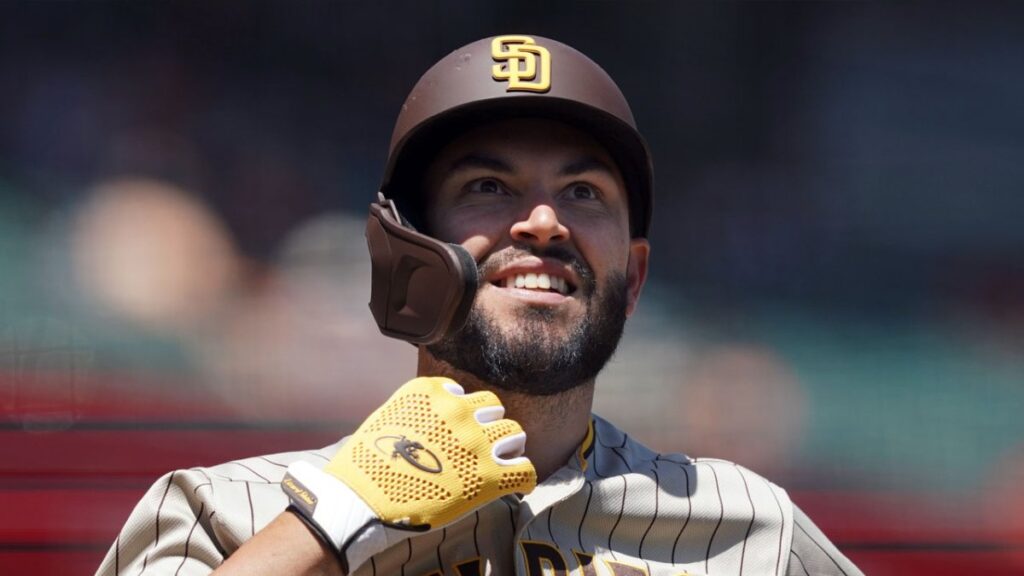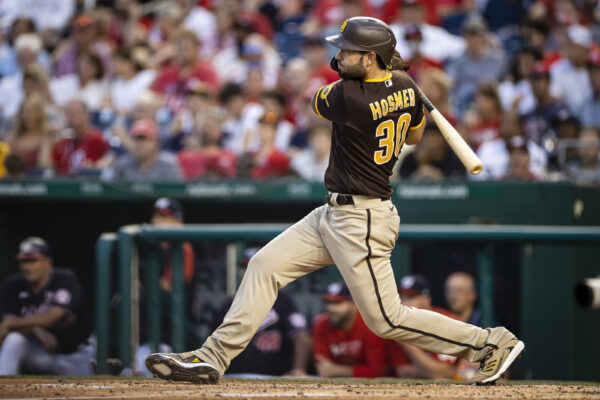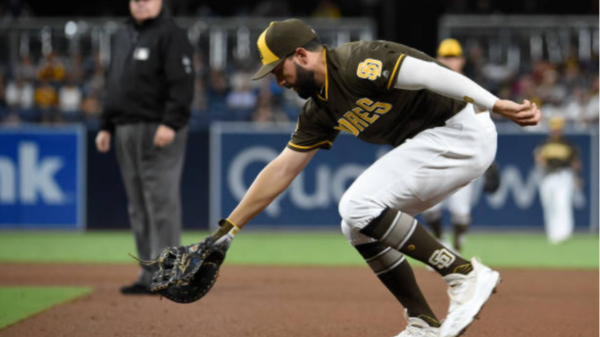The Padres need to trade Eric Hosmer

Credit: AP Photo

Stuck in the middle of the Major League Baseball offseason and a shutdown, there’s no better time to play a game of let’s pretend. So let’s pretend the San Diego Padres improve the team substantially by subtracting one player–Eric Hosmer.
In the 2017 offseason, A.J. Preller, the Padres general manager at the time, surprised the baseball world by signing Hosmer to the most lucrative contract ($144 million over eight years) in the history of the franchise. Just two or three years into the contract, Preller switched gears and started shopping Hosmer and his contract. The constant rumors have undoubtedly hurt the relationship between Hosmer and the Padres. A trade would benefit both team and player.
Although the Royals made some effort to keep Hosmer in 2017, no other franchise showed interest in signing him at the high price his agent Scott Boras demanded. Despite the lack of a bidding war, the Padres chose to make a splash with the acquisition. The move displaced Wil Myers, who had manned first base capably in 149 games in 2016 and 154 in 2017, sending him on a positional odyssey. In his favor, Hosmer had won a World Series in Kansas City and was coming off his best season in the big leagues. In fact, he didn’t miss a game that year and finished with a batting line of .318/.385/.498/.882. Hosmer also came with a reputation of being a team player and a good clubhouse guy.
However, in the era of launch angle, Hosmer hadn’t adjusted and instead insisted on sticking with what had worked for him in the past. In his first year in San Diego, he had the third-lowest launch angle since the advent of Statcast, as well as the fifth-highest ground ball rate in MLB at 46.5 percent.
Although Hosmer won four Gold Gloves at first (including one in 2017), a deeper dive into his defensive abilities reveal a different picture. The year he won his fourth Gold Glove and signed with the Padres, his DRS (defensive runs saved) were subpar at -7. According to FanGraphs advanced defensive stats, he ranked 17th of first baseman with -14.4 Def, .2.0 UZR/150.
By displacing Myers at first, the Padres downgraded the defense. At first base in 2016 and 2017, Myers’ defense was above average–UZR/150 2.0 and 7.5 (FanGraphs). Since the arrival of Hosmer, Myers has played in the outfield and at third. The moves to center field and third base had especially negative consequences defensively and put Myers in an untenable position.In 327.2 innings at third, Myers’ -24.7 UZR/150 obviously hurt the defense. His results in center were disappointing as well (-11.1 UZR/150).

In 2021, Hosmer batted .269/.337/.395/.732. The average first baseman in MLB has an OPS of .810, while Hosmer’s .732 OPS ranks 18th overall, and his 104 OPS+ was 13 points below average. At the age of 32, he’s definitely on the downside of his career, as baseball players tend to peak in their late 20s. This year he also started fewer games (129) than his norm of around 152.
While Myers has also been on the trading block, the Padres appear to be more focused on moving Hosmer and his contract as he is owed $20 million in 2022 and $13 million the following three seasons.
Obviously, the Padres have multiple reasons to move on from Eric Hosmer. If the team manages to unload his contract, the results could improve the defense dramatically. Let’s imagine an infield with Manny Machado at third base, Fernando Tatis Jr. at shortstop, Ha-Seong Kim at second, and Jake Cronenworth at first.
While Tatis is below average defensively at shortstop (UZR/150 -7.1), the rest of the infield would be above the norm, especially with Kim at second (DRS 5, UZR/150 12.4). Of course, his batting average of .202 and OBP .270 must improve dramatically. However, he has had a year to adjust to the American brand of baseball and the much more challenging pitching.
At third, Machado ranks fourth according to Fangraphs’ WAR (4.4), at short Tatis Jr. second with 6.1 WAR. In Cronenworth’s eye-opening first two years in baseball, he’s amassed a total of 5.9 WAR. At first base in a total of 249.1 innings, he has proved he would be a dramatic upgrade defensively (6.7 UZR/150) over Hosmer and offensively as well (.800 OPS 122 OPS+).
Tatis’ balky shoulder and his aversion to surgery must also be taken into account. From the middle of March last year, he dislocated his shoulder five times. He made a total of three trips to Injured List, two for his shoulder, one thanks to Covid. Tatis led the National League with 42 home runs. However, he made a total of 21 errors. Bo Bichette (Toronto Blue Jays) led all of baseball with 24 errors but played 429 more innings than Tatis.
Fortunately, Kim and Cronenworth are both capable of moving to short if Tatis Jr. ends up on the IL next year. Kim, especially, would be an upgrade over Tatis Jr. defensively (Kim DRS 9 UZR/150 2.6). If necessary, Myers could substitute for Cronenworth at first.
[wpedon id=”49075″ align=”right”]
Last year, the Padres went all in, spending money on an unprecedented level. According to Roster Resource, the team is currently carrying an unsustainable $214.7 million in payroll. Obviously, money alone cannot buy championships, as evidenced by the team’s collapse after the All-Star Game. Chasing a playoff berth last year, the Padres also spent prospect talent. Preller will have to try to find a taker for Hosmer while also protecting top prospects like CJ Abrams and Robert Hassell III.
Trading Eric Hosmer would benefit both team and player. Hosmer could ride off into the sunset with his new wife, far away from the constant chatter about his future. The Padres could improve the infield by subtraction without addition. In the off-season, anything is possible for the Padres, from trading Hosmer and improving the infield to winning a World Series.
Baseball has been a part of Diane’s life since her father played professionally (mostly at the minor league level). She has written for a number of publications and concentrated on companion animal welfare. She welcomes the opportunity to write about the sport she loves. Diane shares her home with her husband and a house full of rescued animals.